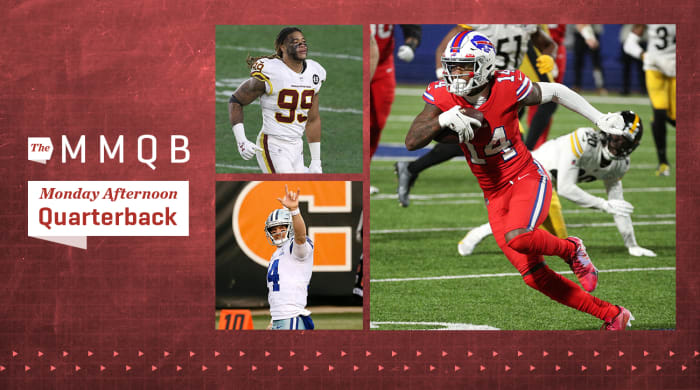Revisiting the Bills’ trade for Stefon Diggs
A normal Monday, with just one game to close out the week. Here we go …

Charles LeClaire/USA TODAY Sports (Young); Sam Greene/USA Today Network (Dalton); Jamie Germano/Rochester Democrat and Chronicle/USA TODAY Network (Diggs)
• After a 10-catch, 130-yard effort on the big Sunday Night Football stage, it’s worth taking a look back now at the Stefon Diggs trade—and why the Bills had faith to take the plunge on a guy who was at times seen as a malcontent in Minnesota. Back in the spring, we went over Buffalo’s rapid pursuit, the compensation and the financials, but we only touched briefly on how Sean McDermott, Brandon Beane and the Buffalo brass got Diggs vetted to the point where they saw him as a culture fit. First, they had something of a mole. Beane’s college scouting director, Terrance Gray, was an area scout for the Vikings when Diggs was drafted and through his first couple years in the league, which gave Buffalo a pipeline into how the receiver was viewed inside the Vikings’ facility. Second, they had connections to people with intimate ties to Diggs. One was Maryland coach Mike Locksley, who recruited Diggs to College Park and was his offensive coordinator for his three years as a Terp. And what came back through all those sources was consistent: Trust would be important, and the Bills would always have to be straightforward with Diggs. But they’d be getting a guy who was competitive and with a practice intensity that recalled Steve Smith, for the handful of scouts and coaches on the Bills staff who were in Carolina before coming to Buffalo. And as for whether he’d rock the boat, word came back that Diggs could be a problem if you were both losing and he wasn’t seeing the ball, but likely wouldn’t be otherwise. So the Bills added it up, saw their program as ready to invest in that kind of player and person, and it’s fair to say that the leap of faith has paid off handsomely.
• While we’re on the Bills, one thing I’ve heard strongly is that coaches and scouts in the organization are championing the cause of defensive coordinator Leslie Frazier for head coaching jobs in the 2021 cycle. Frazier only lasted three years in charge in Minnesota in his first go-round as a head coach. He made the playoffs in Year 2, but couldn’t overcome the decision to take Christian Ponder with the 12th pick in 2011, and was fired after the Vikings went 5–10–1 in 2013. Frazier, for his part, was beloved by the players there (he got a standing ovation after the news he was being let go), and is beloved by the guys in Buffalo too. The Bills were pretty disappointed in Frazier not landing any interviews last year, to the point where owner Kim Pegula—who serves on diversity committees in both the NFL and NHL, and has been a huge advocate of Frazier’s—had decided to bring Frazier to the league meeting last March to meet other owners. Obviously, that meeting was canceled, but the gesture stood out to those in the Bills organization, and Pegula and Frazier wound up sitting together on an NFL panel on diversity later in the spring. So it’ll be interesting to see where this goes. The one strike against Frazier is age (he’s 61). But my guess is that if teams dig into what other coaches and players think of him, they’ll be plenty intrigued. Also, good on Pegula for working to get Frazier in front of other owners. I’ve talked to lots of Black coaches over the last year about networking being an important, sometimes missing piece that the NFL needs to work on to fill the diversity gap.
• One more on Diggs. This one’s only tangentially related. Last year, when the Texans were looking to move DeAndre Hopkins, rumblings of a Hopkins-for-Stefon Diggs deal bubbled up briefly. The Vikings weren’t interested, for a variety of reasons (money was a big one.) Instead,. Minnesota wound up with a draft-pick haul for Diggs, and the first-round pick became Justin Jefferson. Would the Vikings do it all over again? One hundred times out of one hundred. Why? Here are the salary cap numbers ahead for the 28-year-old Hopkins, who’s at $7.006 million for this year: $12.5 million , $25.05 million, $27.2 million, $22.67 million. And here are the cap numbers ahead for the 21-year-old Jefferson, who’s at $2.39 million for this year: $2.98 million, $3.58 million, $4.18 million. On the season, Hopkins has 94 catches for 1,155 yards and five touchdowns. Jefferson has 65 catches for 1,078 yards and seven touchdowns. And that’s taking nothing away from Hopkins. But it does illustrate the value of draft picks. Yes, relying on them is riskier than bringing in a proven vet. But the payoff can be felt for years to come.
• Lost a little in the Chase Young breakout—and we wrote about the Washington rookie’s big afternoon in the MMQB column—is how his bookend played, again. A couple people from the Football Team pointed it out to me on Monday morning, and told me to dig up the pressure stats. So I…
